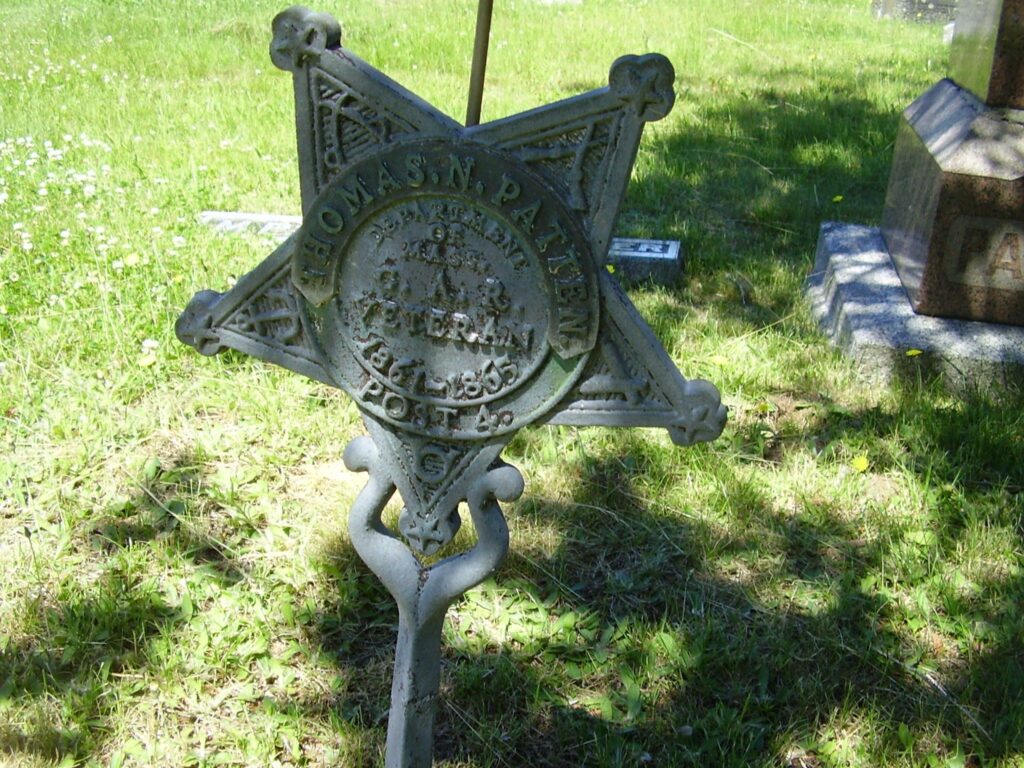
Thomas Nelson Patten, the patriarch of the Hantsport area family by that name, was born 26 August 1838 at River Phillip, Cumberland County, Nova Scotia. He was the son of Isaac Patten and Harriet Parker. They are both buried in Upper Cunard Cemetery, Kings County, Nova Scotia.
On 20 May 1863 Thomas N. Patten enlisted in the United States Army at Bangor, Maine. He was described as age 22, Occupation – seaman, Height – 5ft. 9in., Hair – light, Eyes – blue. He was a substitute, meaning he was paid to take the place of another man who was drafted into the U.S. Army. Thomas Patten served as a Private in the 3rd Maine Infantry – I Company.
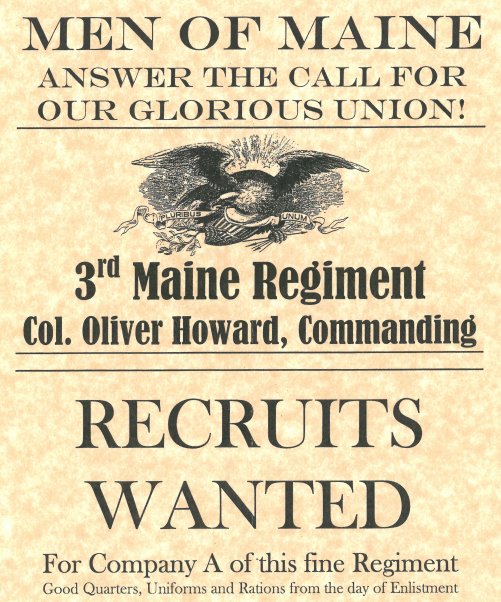
Winter 1863-1864
Thoms Patten’s pension affidavit indicates that he became ill (pneumonia) after sleeping on the cold ground, having crossed the Rappahannock River during a skirmish between troops from the North and South at Kelly’s Ford (about 20 miles from Fredericksburg, Virginia) on Nov. 7th, 1863. He subsequently spent the rest of the Winter (Nov. 22nd, 1863 – Feb. 11th, 1864) at the Lincoln General Hospital in Washington D.C. He rejoined his Regiment in time for the Spring Campaign.
The Battle of The Wilderness – May 5th and 6th, 1864
Both armies suffered heavy casualties, nearly 29,000 in total, a harbinger of a war of attrition by General Ulysses S. Grant against General Robert E. Lee’s army and, eventually, the Confederate capital, Richmond, Virginia.
Thomas Patten was wounded (superficially) May 6th when hit in the thigh by a spent Minié ball from a rifled musket.
The Battle of Spotsylvania Court House – May 8th, to May 21th, 1864
With almost 32,000 casualties on both sides, Spotsylvania was the costliest battle of the Civil War. The Union Army’s assault on the Confederates’ fortifications known generally as “The Salient” and specifically as “The Bloody Angle” involved almost 24 hours of desperate hand-to-hand fighting. Troops including the 3rd Maine Regiment were in the front of the attack. The Union Army broke through the Confederate lines and forced the Rebel troops back to a second “fall back” defensive line early on the morning of the 13th. Heavy rains caused a lull in the fighting from May 13th to 16th but skirmishes took place. During one of those skirmishes Thomas Patten was captured.
Andersonville, Georgia (P.O.W. Camp)
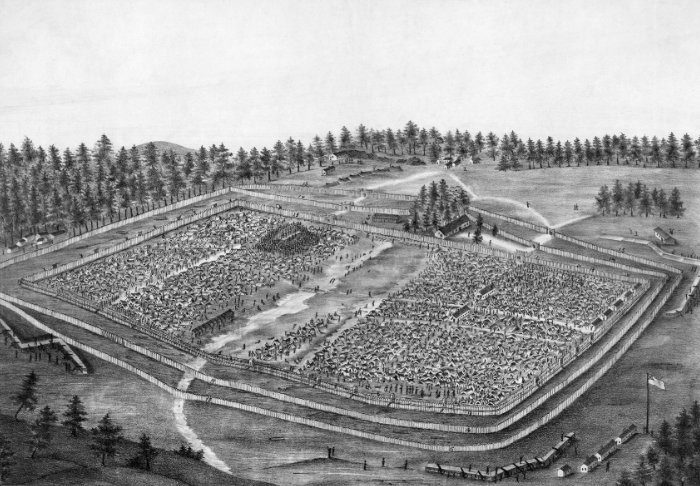
Private Thomas Nelson Patten was captured May 15th, 1864. He was sent to the South’s most notorious prisoner of war camp in Andersonville, Georgia. The prison was overcrowded to four times its capacity, and had an inadequate water supply, inadequate food, and unsanitary conditions. Of the approximately 45,000 Union prisoners held during the war, nearly 13,000 died. The chief causes of death were scurvy, diarrhea and dysentery. He remained there for 10 months until the end of the war.
T.N. Patten was exchanged in Wilmington, North Carolina after the war and again hospitalized (March 6th – Aug 28th, 1865) in Washington before being sent to Maine and discharged. His war experiences affected his health for life.
Return to Nova Scotia
Thomas Patten was mustered out of the U.S. Army on August 28th, 1865. After returning to Nova Scotia he married Rebecca Jane Tracey at Lockhartville Baptist Church on December 12th, 1866. The ceremony was performed by Rev. William Burton and witnessed by Handley and Jane Kelly. Jane was Thomas Patten’s sister. His occupation was given as ‘Carriage Builder’. They lived close to the Kelly and Tracey families in Lockhartville where they were enumerated in the 1871 Census of Canada for the division of Lower Horton.

The couple had two young children living at this time; Sharlotte (Charlotte Ann) age 3 and Sarah (Jane) age 1. A son, William, born in 1868 lived only a few months. Thomas gives his occupation as ‘Carpenter’, is listed of Irish descent and gives his religion as ‘Quaker’. Only 7,345 of the total population (3.48 million) of what comprised Canada at that time identified as a follower of the Society of Friends (Quakers). The testimony for peace and against participation in war appears to be a direct result of Thomas Patten’s own experience.
By the time of the 1881 Census, the family had four new additions; Hattie (Harriet Ada) age 9, Minnie (Minnie Irene) age 7, Terry (Terrence Edward Mortimer) age 4, and George age 1 year. In 1891 the family had grown to include Lilly (Lillian S.) age 8, Flory (Laura J.) age 6, and Fred (Frederick Watson) age 4. Thomas’s occupation was variously listed as ‘Carpenter’ or ‘Carriage Maker’.
Property records show purchases made by Thomas N. Patten in Lower Horton/Lockhartville between 1873 and 1886.
Form Of Affidavit
Of
Claimant
Copy Of Certificate
Nov. 1884
Thomas N. Patton died on 11 June 1902, his wife Rebecca having predeceased him in 1900. Both are buried in Riverbank Cemetery, Hantsport. At his grave there is an iron marker indicating that a veteran of the G.A.R. (Grand Army of the Republic) from Massachusetts is buried there. T.N. Patten’s pension file contains a note from Frederick Patten (a nephew) of Melrose, Mass., where G.A.R. Post #4 was located, requesting a marker for the grave. The nephew wrote his Congressman to request the marker and he sent one for residents of his state, Massachusetts, rather than for the state of Maine.
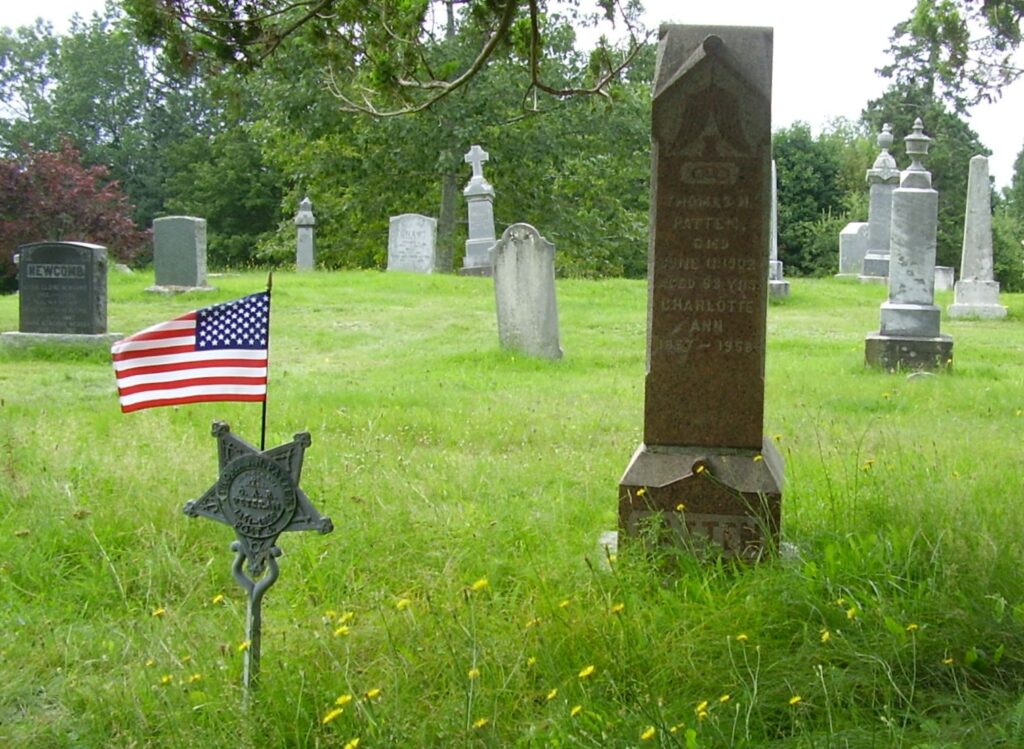
Sources:
“Thomas Nelson Patten” by great-grandson Beverley Burton Patten (1934-1999) – copy held by the Hantsport & Area Historical Society. The manuscript contains much more information on the American Civil War, the organization of the Army of the Potomac and commanders down to I company of the 3rd Maine Infantry, as well as details and maps of the battles in which they were involved.
United States Bureau of Archives and Records, Washington D.C.
Publication Number T289, National Archives Catalog ID 2588825
Index to Pension Files of Veterans – Civil War Pensions
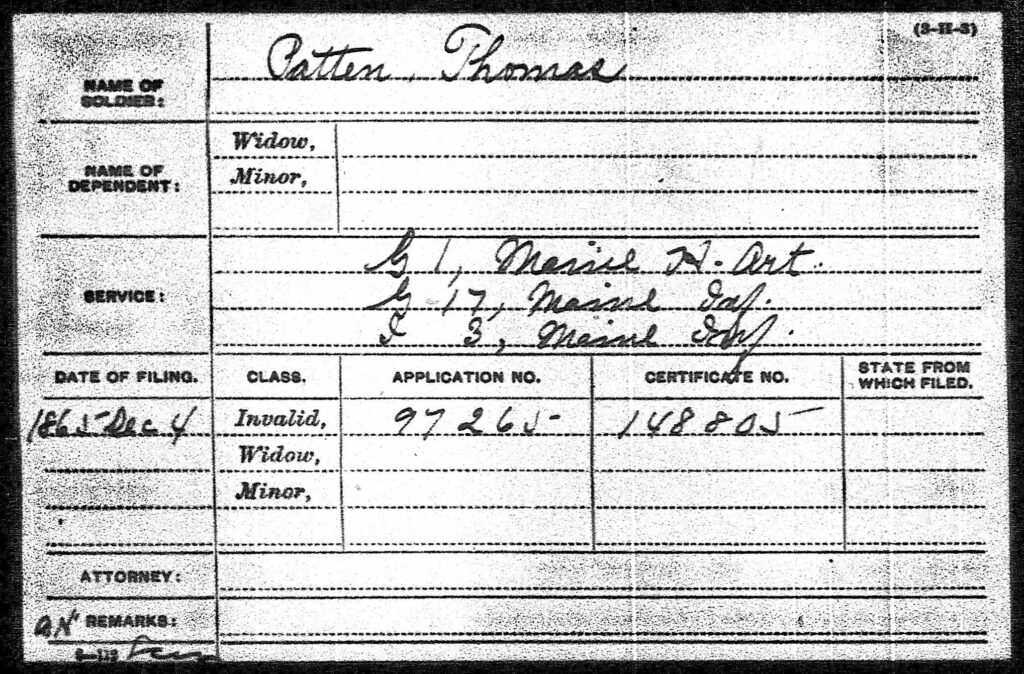
Nova Scotia Historical Vital Statistics, Marriage Registration: Year: 1866 book: 1823 page: 15 number: 55
1871 Census of Canada, Nova Scotia, District 189, Sub-District c (Lr. Horton) Division 2, p. 28, Family #95
1881 Census of Canada, Nova Scotia, District 17 (Kings), S. District i, Division 2, p. 26, family #123
1891 Census of Canada, Nova Scotia, District 37 (Kings), S. District 18 (Lockhartville), p. 24, family #122
Kings County Registry of Deeds; 1873 Book 34/Page 395, 1880 Book 43/Page 43, 1886 Book 51/Page 570.
